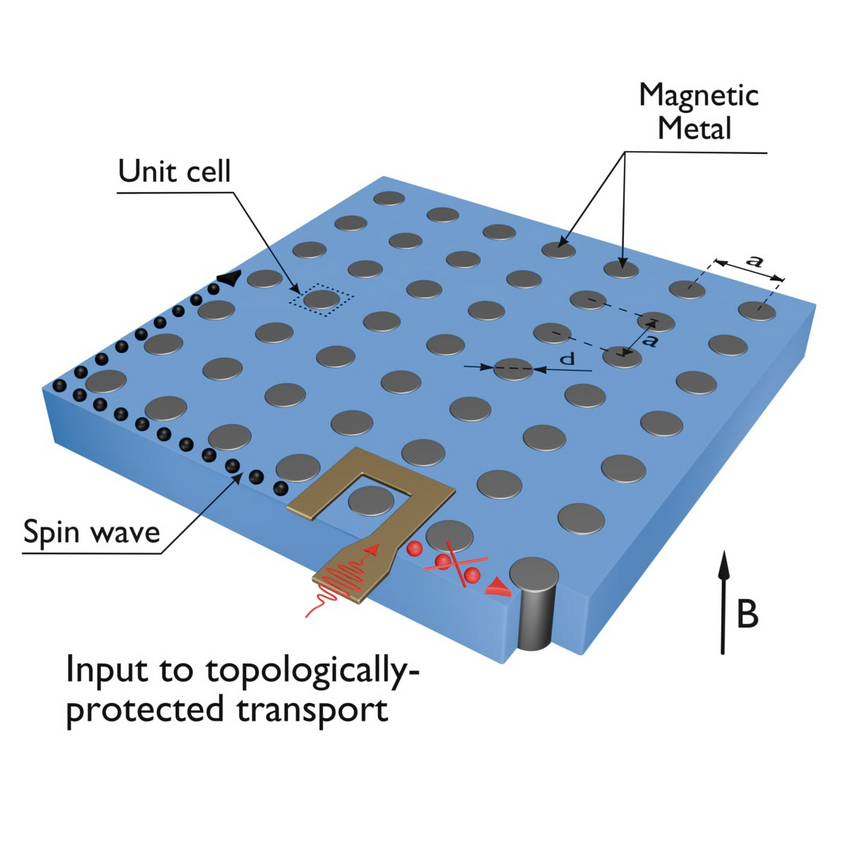Nanoscale Topological Magnonic Crystals (FWF ESPRIT "TopMag")
FWF ESPRIT ESP 526 project TopMag “Nanoscale Topological Magnonic Crystals"
01.11.2023 – 31.10.2026
Principal Investigator: Dr. Khrystyna Levchenko
Project Staff: Kristýna Davídková (PhD student), Andrey Voronov (PhD student)
External Collaborators:
Innovent Technologieentwicklung - Jena, Germany
Team: Dr. Carsten Dubs
Institute of Spintronics and Quantum Information, Poland
Team: Prof. dr hab. Maciej Krawczyk

Faster, smaller, more efficient – this motto for technological progress led to the computerisation and automatisation of everyday life. However, modern CMOS electronics and communication technology face fundamental drawbacks ranging from relatively low operational frequencies and associated limited speed of data processing to high power consumption. How do we tackle these?
One prominent way is magnonics – an advanced field that studies information transport and processing by spin waves in addition to or even instead of electric currents. Spin wave is a collective propagation of the magnetic moments of atoms in a solid body, akin to a water wave across the surface of a pond. Their fundamental units (or quanta) are called magnons, giving its name to the field. The use of spin waves allows for higher than conventional operational frequencies, low energy losses, no heat dissipation and low power consumption. Magnonics already successfully developed prototype circuitry elements, many of them designed in the form of sub-millimetre magnonic crystals (MCs) – artificial magnetic materials. Yet, in order to surpass modern technology, magnonics units’ size should be at least in the sub-micrometre range. Most importantly, this device should work reliably on such a small scale, as even few imperfections could negatively impact performance.
To address these challenges, we propose to combine magnonics and topology – a branch of mathematics, that studies material’s properties which are invariant under continuous transformations. Such a union would allow to analytically predict and realise a structure with a range of unique properties, such as efficient and low-loss propagation, or robustness to defects. Therefore, a strategic goal of the TopMag project is to explore topological magnon transport via experimentally realised topological magnonic crystals (TMC) at the nanoscale.
This is a highly innovative approach, as a majority of the available research in topological magnonics is theoretical, with only a handful of niche experimental realisations due to the field’s young age. Considering the emergence of works on the topological transport in accessible magnonics materials, progress in the growth of the high-quality nanoscale films of these materials and, their respective nanofabrication, it is time to fill the experimental gap. Based on our preliminary studies and the theoretical base, we expect the bi-component magnonic crystals made from the nanometre-thick Gallium-substituted Yttrium Iron Garnet (Ga:YIG) films with out-of-plane anisotropy to be among the best candidates to realise robust topological spin wave transport.
To test our hypothesis, we will use a variety of modern nanofabrication instruments to create the magnonic crystals. Afterward we will use a wide range of experimental techniques to characterise and investigate magnon transport, complemented by micromagnetic simulations to provide valuable insights and support for our findings.
